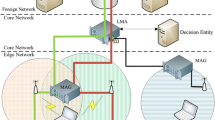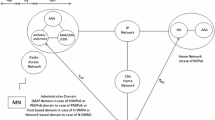Abstract
We propose a new network layer mobility architecture called Mobile NAT to efficiently support micro and macro-mobility in and across heterogeneous address spaces common in emerging public networks. The key ideas in this architecture are as follows: (1) Use of two IP addresses – an invariant virtual IP address for host identification at the application layer and an actual routable address at the network layer that changes due to mobility. Since physical address has routing significance only within a domain, it can be a private address and therefore, does not deplete the public IP address resource. (2) New DHCP enhancements to distribute the two addresses. (3) A new signaling element called Mobility Manager (MM) that uses Middlebox Communication (MIDCOM) framework to signal the changes in packet processing rules to the Network Address Translators (NATs) in the event of node mobility. Our proposal does not require any modifications to the access networks and can seamlessly co-exist with the existing Mobile IP mechanisms and therefore, can be used to provide seamless mobility across heterogeneous wireline and wireless networks. We report implementation details of a subset of our ideas in a testbed with Windows XP clients and Linux based NATs.
Similar content being viewed by others
References
P. Bhagwat, and C. Perkins and S. Tripathi, Network layer mobility: An architecture and survey, in: IEEE Personal Communications, (1996) 54–64.
M. Buddhikot, G. Chandranmenon, S. Han, Y. W Lee, S. Miller and L. Salgarelli, Integration of 802.11 and third generation wireless data networks, in: IEEE INFOCOM 2003 (April, 2003).
A.T. Campbell and J. Gomez, IP micro-mobility protocols. IEEE Wireless Communications 4 (2001) 45–54.
A. T. Campbell et al., Comparison of IP micro-mobility protocols, IEEE Wireless Communications 9 (2002) 54–64.
J. Chiappa, Endpoints and endpoint names: A proposed enhancement to the internet architecture. Work in progress (1999). http://users.exis.net/jnc/tech/endpoints.txt.
R. Droms and Ed. W. Arbaugh, Authentication for DHCP messages, RFC 3118, IETF (June 2001).
General Packet Radio Service (GPRS) Service Description (Stage 2). TS 122 060, ETSI (2002).
E. Gerich, Guidelines for management of IP address space, RFC 1466, IETF (May 1993).
E. Gustafsson, A. Jonsson and C. Perkins, Mobile IPv4 regional registration. Work in progress—Internet Draft (Nove. 2003). draft-ietf-mobileip-reg-tunnel-08.txt.
http://udhcp.busybox.net/. Technical memorandum (April 2002).
S. Kent and R. Atkinson, Security architecture for the internet protocol, RFC 2401, IETF (Nov. 1998).
H. Levkowetz and S. Vaarala, Mobile IP traversal of network address translation (NAT) devices, RFC 3519, IETF (April 2003).
A. Misra et al., IDMP-based Fast handoffs and paging in IP-based cellular networks, in: 3GWireless 2001 (May 2001).
R. Moskowitz and P. Nikander, Host identity protocol architecture. Work in progress—Internet Draft (Sept. 2003). draft-moskowitz-hip-arch-05.txt.
R. Moskowitz, P. Nikander, P. Jokela and T. Henderson, Host Identity Protocol. Work in progress—Internet Draft (Oct. 2003). draft-moskowitz-hip-08.txt.
Charles Perkins. IP encapsulation within IP. RFC 2003, IETF, (Oct. 1996).
C. Perkins (Ed.), IP Mobility support for IPv4, RFC 3344, IETF (August 2002).
R. Ramjee, L. Li, T.F. La Porta, and S. Kasera, IP paging service for mobile hosts. In Mobile Computing and Networking, (2001) 332–345,.
R. Ramjee, K. Varadhan, L. Salgarelli, S. R. Thuel, S. Wang and T. La Porta, HAWAII: A Domain-based approach for supporting mobility in wide-area wireless networks. IEEE/ACM Transactions on Networking, June 2002, 4:45–54.
Y. Rekhter, B. Moskowitz, D. Karrenberg, GJ. de Groot and E. Lear. Address Allocation for Private Internets. RFC 1918, IETF (February 1996).
J. Rosenberg et al. (Ed.), Session initiation protocol. RFC 3261, IETF (June 2002).
W Simpson. IP in IP Tunneling. RFC 2003, IETF, October 1995.
P. Srisuresh and K. Egevang, Traditional IP Network Address Translator (Traditional NAT). RFC 3022, IETF January 2001.
P. Srisuresh, J. Kuthan, J. Rosenberg, A. Molitor and A. Rayhan. Middlebox communication architecture and framework. RFC 3303, IETF, Aug. 2002.
G. Su and J. Nieh, Mobile communication with virtual network address translation. Department of Computer Science, Columbia University, CUCS-003-2, (Feb. 2002).
R.P. Swale, P. A. Mart, P. Sijben, S. Brim, and M. Shore. Middlebox Communications (midcom) Protocol Requirements. RFC 3304, IETF, (August 2002).
TIA/EIA/IS-835B – cdma2000 Wireless IP Network Standard. Third Generation Partnership Program 2 (3GPP2) (2000).
F. Vakil et al, Supporting mobility for TCP with SIP. draft-itsumo-sipping-mobility-tcp-00.txt, IETF (Dec. 2001).
A. G. Valko, Cellular IP A new approach to internet host mobility, ACM Computer Communication Review (Jan. 1999).
Author information
Authors and Affiliations
Corresponding author
Additional information
Milind M. Buddhikot is a Member of Technical Staff in the Center for Networking Research at Lucent Bell Labs, Holmdel, NJ. Milind holds a Doctor of Science (D. Sc.) in computer science (July 1998) from Washington University in St. Louis, and a Master of Technology (M.Tech.) in communication engineering (December 1988) from the Indian Institute of Technology (I.I.T), Bombay. His current research interests are in the areas of systems and protocols for integrated public wireless networks, authentication and dynamic key exchange protocols, Voice-over-IP (VOIP) networks, and sensor and ad-hoc networks. He has authored over 26 research papers and 9 patent submissions in the areas of design of multimedia systems and protocols, layer-4 packet classification, MPLS path routing, authentication and dynamic key exchange, and 802.11/3G integration. Milind currently serves as the Associate Editor of the IEEE/ACM Transactions on Networking. He also served as a co-guest-editor of IEEE Network magazine’s March 2001 Special issue on Fast IP Packet forwarding and Classification for Next Generation Internet Services. He has served in the capacity of a tutorial chair for IEEE LCN 94, 95, as a publicity chair for NOSSDAV97, and as a program committee member for MMCN 2001, 2003, IEEE ICNP2002, 2003 and IEEE LCN 93-2000 conferences.
Adiseshu Hari received a Doctorate in Computer Science from Washington University in St. Louis in 1999, and has since been at Bell Labs, Lucent Technologies, where he’s worked on projects related to network design and optimization. He’s currently looking at design issues in large scale SIP based VoIP networks.
Kundan N. Singh received a B.E.(Hons) degree in Computer Science from Birla Institute of Technology and Science in India, M.S. in Computer Science from Columbia University, and is continuing his studies towards Ph.D. degree in the same field at Columbia University in New York City. As a research assistant in the Internet Real-Time Lab at Columbia University, he is doing research on Internet telephony, SIP-H.323 signaling gateway, unified messaging systems and multimedia conferencing.
Scott Miller is the Director of the High Speed Mobile Data Research department at Bell Labs in Holmdel, New Jersey. He has B.S. and M.S. degrees in electrical engineering from Cooper Union in New York City. His current research involves the integration of 802.11 and 3G wireless data service and the related mobile networking issues concerning seamless mobility, authentication, security, roaming, and accounting. Prior to his work on 802.11/3G integration, Scott has led several systems research efforts in wireless applications, implementing novel systems for wireless messaging, speech-driven directory services, wireless instant messaging, carrier-based content billing, and multi-media content adaptation.
Rights and permissions
About this article
Cite this article
Buddhikot, M., Hari, A., Singh, K. et al. MobileNAT: A New Technique for Mobility Across Heterogeneous Address Spaces. Mobile Netw Appl 10, 289–302 (2005). https://doi.org/10.1007/s11036-005-6423-3
Issue Date:
DOI: https://doi.org/10.1007/s11036-005-6423-3




